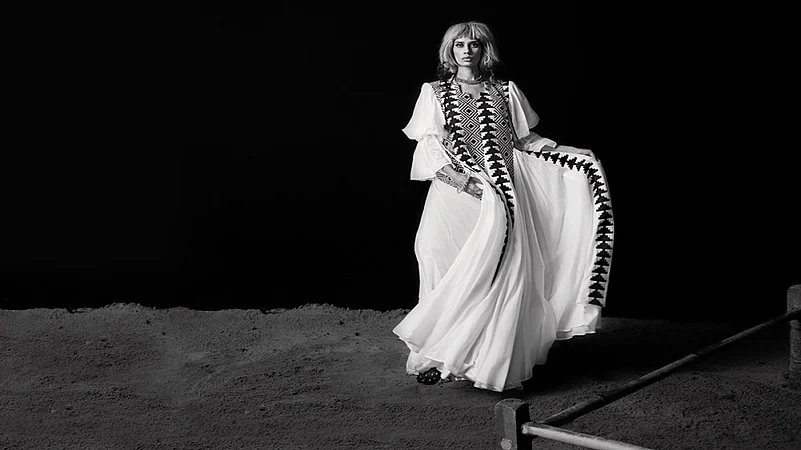Running a fashion label from a small town of Uttar Pradesh is quite a challenge. It has always been so, ever since I started operating this international business from Saharanpur in the western part of the state and about 200 km from the national capital. But not once has the thought ever crossed my mind that I could relocate to a big city to make my life easier. You could ask why. Truth is, I cannot work without my people. Yes, I call them “my people”. They are the people of Saharanpur, my place in the world. And they have kept their faith in me. Faith and hope. In me and my work they see a new ray of light, and a sense of security—some of which is linked to the assurance of a livelihood.
In fact, I owe a lot to my people. Small-town life and the world of artisans living there deeply influence the visual imagery of my designs. I work with marginal communities that are directly or indirectly contributing to the fashion industry. The Indian artisan is my inspiration, especially communities associated with vocations that are in their last gasp, so to speak—the dhobi (washerman), the rafugar (darner), the kadhaaiwala (embroider), the kumhaar (potter) and so on. In every collection, I try to portray the untold story of Indian artisans and connect ‘non-fashion’ industrious people with the fashion industry, while providing them employment in the process.
Let me explain with an example. My first collection was called ‘Dhobi Ghat’ (2017). There was this washerwoman who used to come to our house regularly. Her name was Sakina Begum. There is a common practice among dhobis across the country—most of them make some small mark on the cloth before washing it, for making it easier to identify the house it came from. For my collection, Sakina and 30 other women pressed such marks on to the whites, making a design. For this particular style, which I call the ‘bhalwa print’, I found inspiration in dhobis, in the marks they make on clothes. And now, the dhobi who can no longer wash clothes, because there is no dhobi ghat anymore, is connected instead with the fashion industry—doing printing.
Born and brought up in a family engaged in the wooden handicraft business for which Saharanpur is well-known, my own journey in fashion started when I joined a senior in school to set up a boutique. I was in Class 9 then. I went on to graduate from the Inter National Institute of Fashion Design, Chandigarh. Following a stint as a subject matter expert with the Sector Skill Council (Apparel), I made my debut at the Lakme Fashion Week spring/summer 2018 and was named among the most promising GenNext fashion designers. I had registered my label under a national employment scheme. The next big step was making it to the Forbes India 30 under 30 list in the special category.
I always work only with whites and monochromes. My designs have found a big buyer in the Middle East. I have also designed for many film stars in Bollywood. But my childhood memories continue to inspire me. In my recent collection for Lakme and the Fashion Design Council of India, I draw inspiration from the string-cot weavers I remember. This collection is called ‘Meri Pyaari Khaat’ (My dear cot).
I take immense pleasure in the fact that my people—those I am inspired by, those who I work with—find hope in my work. But this also brings me a big responsibility, which can sometimes feel like a challenge, at other times like pressure. And since the pandemic and the lockdowns that were imposed in its wake, I have been in fear. A big fear.
Before the pandemic, the fashion industry was at its peak. Then came the disruption. Nature proved that there is a supreme power running this universe. These one-and-a-half years have been the most challenging for me as a designer, and also as a businessman. In my small town, I am working with around 200 people from the marginal communities. Our work together keeps all these households running. That’s why I was afraid when the lockdown began. How do I provide all these families with their basic needs? How can I support them now? They are the people who made me. How do I keep them alive? These were the questions on my mind. At that point, I wasn’t thinking about my business or my creativity. Keeping the team alive was the priority. I asked for help from many organisations, but was largely disappointed as residents of metros seemed to be their priority.
The biggest challenge we faced was the change in the attitude of international buyers. With non-essential retail shops closed and other restrictions, many buyers cancelled contracts or re-negotiated the terms. Workers had to face closures and layoffs. Another problem was that the stocks we had produced would become redundant.
Lockdown 2.0 was worse than the first one. I lost more than a fourth of my team. The lockdown is over now, but I find the market confused. It’s hard to understand the likes and dislikes of clients. Prices of fabrics and raw materials have gone up suddenly. Some quality materials have disappeared because of stalled production. I am confused about what to produce, when to produce, how much to produce—it looks like I am studying the first chapter of my Class-11 economics textbook! If there is another lockdown, I am sure that would be the end of our dreams.
(This appeared in the print edition as "My People And Our Fashion")
(Views are personal)
ALSO READ
Mohammed Mazhar is a fashion designer based in saharanpur, UP
















